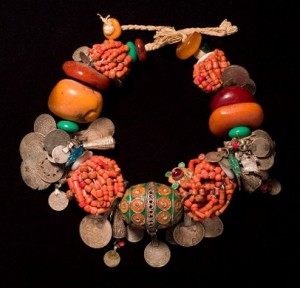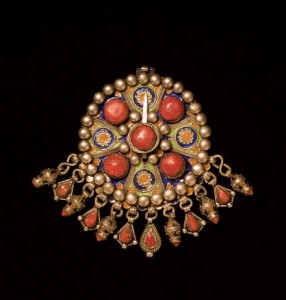
It’s the kind of jewelry you might find in a Moroccan street market or on a well-dressed belly dancer: colorful, exotic layers that clink and jangle as the wearer moves.
Xavier Guerrand-Hermès, a director of the Paris-based fashion empire, spent three decades collecting North African jewelry and photography, and the creme of his collection is on view at the Philadelphia Museum of Art and the accompanying book Desert Jewels.
Surrounding the jewelry cases are textiles from the region and photographs of the characters who inhabited it in the late 19th and early 20th century. Don’t expect much jewelry in these shots, beyond a couple portraits of women in headdresses, belts and necklaces. But the photos lend a sense of place for the jewelry, most of it displayed for the first time.
One case is devoted to jeweled headbands worn with veils. Nearby are elaborately beaded necklaces bulky enough to double as body armor.

With the exception of a few gold fibulae, most of the jewels are of silver and not-so-precious beads. What stands out are the flamboyant colors and textures – chunky coral and amber beads layered with green-and-gold enamel work and engraved silver from Tiznit, glass, coins, buttons, shells, a few faux rubies.
A lot of what North African women wore, they made themselves. “All kinds of materials were mixed together in these amazing compositions, mostly self-made,” says Enid Schildkrout, curator for the Museum for African Art. “There are specialist silversmiths and goldsmiths but people would often remake the jewelry. If you look closely, you can see these pieces could be taken apart and recombined, the same way people would unravel old textiles and reweave them into something else.

“We tend to think of jewelry as something fixed the way you bought it, but these are very rich assemblages that can be taken apart so even the elements could be traded and valued separately.”
Jewelry has always been the ultimate form of portable wealth, after all. “Jewelry was worn in North Africa for a lot of reasons,” says Schildkrout. “It was worn as a sign of beauty, wealth, status, demarcating whether a woman was married or not married.” (Some things haven’t changed.)
“Women would collect jewelry and wear it but it was also a form of stored wealth because a woman could sell her own jewelry.” A woman’s jewels were a form of protection, she says, both from the poverty of divorce and the ever-present Evil Eye.
An especially potent, protective symbol in North Africa was the hand. One case in the exhibit is filled with jewelry designed around hand-shaped pendants and charms known as khamsa.

“In the image of the hand, or khamsa, the five fingers relate to the five pillars of Islam,” Schildkrout says. “That made it a protective amulet or charm.”
And yet, at least one silver khamsa pendant here is covered with Hebrew inscriptions. A lot of the silversmiths who made these jewels were Jews, Schildkrout explains, many of whom came to Morocco during the period when the Muslims ruled Spain.
It’s just one example of the merging of cultures that makes North Africa such an exotic and mysterious place. Kind of makes sense that a Hermès would find this stuff so inspiring, doesn’t it?

Desert Jewels: North African Jewelry and Photography from the Xavier Guerrand-Hermès Collection, organized by the Museum for African Art in New York, opened at the Philadelphia Museum of Art on September 4 and runs through December 5.
All images here are courtesy of Karen L. Willis/Museum for African Art
Related posts
Best books for jewelry lovers: Celebrating Jewellery
Ancient gold jewelry: timeless beauty, technical mastery
Ancient jewelry you can buy for $3000 or less
Related products

